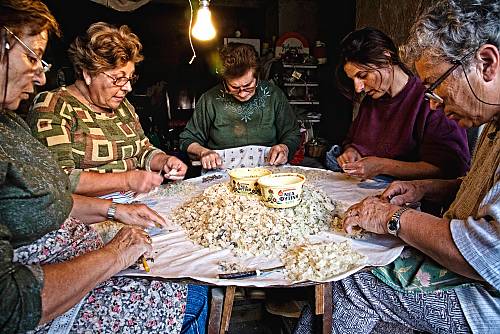
Did you know that you could actually make Greek traditions and customs a part of your trip to Greece? Well, yes, and today I introduce you to eight cherished Greek heritage traditions and practices that take you deeper into the Greek way of life and where to find and experience them.
When travelers think of Greece, the first thing that comes to mind is the sea, the sun, the white-washed island footpaths and the food. In short, all those things that make up Greece’s legendary hospitality. But if there is one thing that travel should be doing, it’s bringing people together and heightening the understanding and respect of diversity.
As times change prompted (sadly) by terrible human actions, travel takes on a new significance: it teaches us about each other and it inspires us to look beyond the obvious to all those things we share.
👉🏼 Find the best hotel deals for you
What is an UNESCO Listed Heritage Tradition?
Now more than ever, travelers are seeking to experience a culture, to immerse themselves in the lives of the peoples they visit, getting a real hands-on feel of what life is like, how they came about to be who they are, what inspired their music, art, architecture, food, dance, traditions, temperaments.
That’s what UNESCO had in mind in 2008, when it decided to create a list of intangible cultural heritage, bringing forth traditions, customs, cultural spaces and practices across the globe that must be preserved because they are also an integral part of world heritage – our heritage.
The idea behind UNESCO’s lists is to highlight the diversity of this heritage, raise awareness about its importance, and, for me, bring us closer together into a unified whole – a society of respect, which I believe is the singular and paramount meaning of travel.
Greece’s Treasured Traditions with the Seal of UNESCO
That said, this week The Greek Vibe will take you through eight treasured traditions and practices “made in Greece” that will offer you insight into the Greek way of life and will take you beyond its famed beaches and bars, into its colorful culture and history.
The Greek traditions or practices inscribed on UNESCO’s List of Intangible Cultural Heritage and recognized as significant universal expressions of heritage are listed below and I’ve provided information on where to find these:
► The secrets behind the traditional Cretan knife
1. The Byzantine Chant – The Voice of Angels
What’s it’s all about?
Included on UNESCO’s list in 2019, the psaltic art form of Greece and Cyprus is an eight-mode music system formulated in Byzantine times more than 2,000 years ago. It lives on in Orthodox church services with three or more cantors or “psaltes” chanting the holy scriptures. The sacred monophonic vocal tradition was initially passed on orally from one generation to the next and is an integral part of spiritual life and religious worship. It has remained unchanged over the centuries.
► All the Reasons Cyprus should be on you bucket list
Where can I experience Greek psaltic art?
You are bound to hear Byzantine chants or “psalmodies” during Orthodox church services. The most compelling of these chants are performed during Orthodox Easter at church. One of these it the hymn to female poet and saint Kassiani delivered on Holy Tuesday. You can also hear chants at monasteries delivered both by monks and nuns as a way of spreading God’s word and reaching out to god. Today, there are specialized music schools teaching the psaltic art as well as musicologists and scholars dedicated to its study, performance and dissemination.
A gripping sample of psaltic art is delivered by vocal ensemble Cappella Romana, who could be heard (below) recreating the sound as it would have sounded in the Hagia Sophia, one of the grandest Byzantine monuments in the world and a key component of Greek Orthodox faith, history and heritage.
►Three Perfect Greek Easter Getaways
2. The Greek Nomad – Moving with the Animals
What’s it all about?
Also referred to as “transhumance”, the centuries-old practice of moving “nomadically’ from the lower lands to the higher pastures over the year with the change of seasons was included on UNESCO’s list in 2019.
The practice is a form of pastoralism that involves the seasonal droving of livestock from one geographical location to another. At a time when climate change and safeguarding the planet is more crucial than ever, this nomadic practice offers insight into the care and breeding of animals, sustainable management of the land, forests and water resources, and ways to address natural hazards.
Where can I experience Greek nomad life?
One of the best Greek destinations to experience the movement of livestock is on the island of Crete. The ritual is a very important part of the life of herdsmen (and women) on the island and includes a celebration with food and drink marking the move from lower to upper pastures, known as “himadia” – in Greek meaning to “offer shelter in winter”. The move can take weeks. Ideally, you can catch a glimpse of this practice during the switch of seasons, the most important being from autumn to winter. There is currently a network in Greece of 3,000 herdsmen involved with the preservation of transhumance.
3. Greece’s ‘Xerolithies’ – The Craft of Dry Stone Walls

What’s it all about?
The traditional practice of building stone walls to set apart properties has been an important part of Greek culture since prehistoric times. Known as dry stone wall masonry, the practice was included on UNESCO’s list in 2018 and involves stacking stones one on top of the other without using other materials apart from dry soil and water.
Where can I find ‘xerolithies’ in Greece ?
You can find “xerolithies” everywhere in rural Greece: from the islands to the mountain villages. “Xerolithia” means “dry stone” in Greek and it is evidence of how resourcefully people used whatever was available in their surroundings respecting at the same time the harmony of the environment. That’s why the Greek islands won over thousands of travellers in the 60s and 70s – the whole ecosystem operated in unison.
You can find representative “xerolithies” or dry stone walls samples on the island of Tinos, on Zakynthos and across Greece, with each region possessing its own trademark style. I should add, that the craftsmen would pass on the secrets of trade from father to son.
► Great Greek Islands to Visit in November
4. The Rebetiko – the Greek ‘Blues’
What’s it all about?
The rebetiko is perhaps one of Greece’s most important music genres in that it is the root source of the country’s contemporary popular music. Also known as the “Greek blues”, the style was associated in the past with the outcasts and laymen of Greek society only to spread to upper class entertainment, later becoming an integral part of Greek music culture. Similar to the American blues and Portuguese fados, it was inscribed on UNESCO’s list of the Intangible Cultural Heritage of Humanity in 2017.
Where can I experience rebetiko music in Greece?
If there’s one experience travellers to Greece should not miss, then that definitely is getting to hear the rebetika live: it offers insight into the locals’ soul and it brings people closer.
►Where to get the genuine rebetiko experience in Athens
The broad genre incorporates a number of sub-styles and influences as well as dance and is overall a cultural product of Greece’s turbulent history as well as of its geographical location, at the crossroads of East and West.
Despite being banned for quite some time, the rebetiko went from a music genre to something greater: it became a way of life. You can experience the rebetiko at venues throughout Greece known as “rebetadika”, however it is very important to make sure you’re getting the real thing. For a complete history, the unwritten rules of the rebetiko as well as how to recognize the genuine version and where to listen, go here.
5. Meet Greece’s ‘Momoeri’ – Kozani’s ‘Old Men’
What’s it all about?
The “Momoeri” or “momogeri” is a 12-day ritual marking Christmas, New Year’s and Epiphany, which combines ancient Greek drama with street theatre. From December 25 to January 5, a group of males mostly dressed as old fighters dance throughout the streets of eight villages in the Kozani area, West Macedonia. The custom dates back to the ancient times and was included on UNESCO’s intangible heritage list in 2016.
Believed to have been “Christianised” by the Pontic-Greeks, the Momoeria is practiced annually and meant to ward off evil through loud noise and teasing. In ancient Greece, the Momos was a god of mockery.
As the 12-day holiday season comes to a close, the Momoeri have chased off darkness and welcomed the light with wishes of prosperity for the new year ahead, healthy offspring and bountiful harvests.
The Momoeria include traditional elements of Western Macedonian history, tales and myths, music and drama as well as handmade costumes which are passed down from father to son. Participtation is a form of initiaition for the young boys.
Where can I experience Greece’s Momoeri?
In northern Greece, from Christmas to January 6. Much like the Apokria – Greece’s carnival traditions – you will see the Momoeri running around town taunting and teasing. The Momoeria festivities come to a close at the main square where visitors and villagers sing and dance around a fire with plenty of food and drink until daybreak. The music is Pontic Greek with traditional Pontic lyre, bagpipe (pipiza) and daouli drum.
👉🏼 Find the best hotel deals for you
6. The Marble Masters of Tinos
What’s it all about?
The Greek island of Tinos in the Cyclades is famed for its marble masters whose works can be found across the country. The art of marble-carving as an expression of the cultural identity of Tinos was included on UNESCO’s list in 2015. The island bore some of the country’s finest craftsmen thanks to its vast reserves of white and green marble. Tinos marble has actually been used on dozens of Greek art works and marble masters from the island are said to have worked on the construction of the sacred island of Delos in antiquity.
►Tinos: A Greek Island Where Miracles Still Happen
It is said, that Phidias, the Greek sculptor behind one of the Seven Wonders of the Ancient World – the statue of Zeus at Olympia – and of Athena located in the Acropolis, shared his knowhow with the islanders on his way to Delos.
⛴ Book your ferry to the Greek islands here
Where can I find Tinos marble?
On Tinos, of course, on your way to Mykonos. The majority of the island’s famed craftsmen, including Giannoulis Chalepas, who is – among others – known for his exquisite sculpture of 18-year-old Sophia Afentaki at the First Cemetery of Athens, were born on Tinos. So important was the profession, that there are actually traditional island (nisiotika) songs dedicated to the art of crafting marble.
To get a taste of the superb marble art works you should visit the picturesque village of Pyrgos, where today you will also find the Museum of Marble Crafts, a museum dedicated to Chalepas (his home), dozens of marble workshops, galleries, the Tinos School of Fine Arts, and shops selling such items as shot glasses made of pure white Tinos marble.
7. Greece’s Miracle Droplet: Mastiha Chiou

What’s it all about?
A miracle drop, the natural resin from the mastic tree of Chios island is known worldwide for its numerous health benefits. Mastiha is cultivated entirely by hand from the aromatic mastic resin, which is extracted from the shrub pistacia lentiscus. The EU has already granted mastiha the PDO label, which means that it is legally protected as unique to Chios product.
Included on UNESCO’s list in 2014, the traditional harvesting and cultivation of mastiha Chiou dates back to the 8th-7th century AD and has supported the livelihoods of thousands of families on the island.
The harvest takes place from the beginning of July to the beginning of October and there is a clear division of labour in the process with males fertilising and pruning the shrubs in winter and the females levelling and sweeping the ground around the trunk to extract the mastic in summer.
Also known as the “tears of Chios”, the extraction of mastiha is a painstaking and costly practice that is passed on from generation to generation through word of mouth.
☞A map of Greece will definitely come in handy. I recommend you get this easy-to-read and detailed waterproof adventure map of Greece by experts NatGeo. A great tool!
Where can I experience it?
On Chios, the fifth largest island of Greece located in the northeastern Aegean Sea. Besides its vast history and medieval settlements, you’ll have a chance to see first-hand how mastiha is collected (in July) when you visit the 24 southern villages of Chios, known as the “mastihohoria”.
►How to Drink Ouzo, Raki or Tsipouro
Once the process is completed you can “experience” mastiha in everything from ouzo, ice cream and loukoumia (my grandmother would eat one with her coffee) to the creamy spoon sweets – this one is totally addictive, chewing gum, and the popular liqueur. Greeks also use it in their sweets and herbal medicines, to make surgical threads, soap and cosmetics. Chewing on mastiha, this is my favorite, has proven to do wonders for digestive problems and ulcers. If you are lucky, you may find yourself in a family gathering during the mastiha process listening to long tales of the past and traditional island songs.
👉🏼 Dream of visiting Greece? Start planning
8. The Famed Mediterranean Diet
What’s it all about?
Inscribed in 2013 on UNESCO’s List of the Intangible Cultural Heritage of Humanity, the Mediterranean Diet – also known as the Greek Diet – came into the headlines in the late 1960s, when scientists discovered a link between the foods eaten and long life expectancy.
With research conducted in Greece (Crete) and in the Greek-speaking villages of southern Italy, the diet – consisting mainly for fruits, vegetables, and legumes, extra virgin olive oil, and very limited meats, dairy, and sweets – is an integral part of Greek culture as is evident in everything from its cuisine, conservation and consumption to farming and fishing practices, products and lifestyle. It is also practiced to this day in many countries of the Mediterranean basin.
The diet today, backed with a set of rules and knowhow, and based on the rituals and traditions of our forefathers, has become the foundation of a healthy lifestyle.
►‘The Mediterranean Diet – Cookbook For Beginners’ – A great place to start
Where can I experience the Greek Diet?
The basic idea behind the Mediterranean Diet is nourishing the body with fresh products that are in season and avoiding additives, meats, fats, and sweets.
I was lucky enough to have experienced the Greek diet first-hand from my grandparents, whom I remember clearly following a strict program of eating times, specific foods during the week, no eating after a certain hour and lots of fruits and vegetables. Sweets, I remember (to my dismay), were allowed only on Sunday and on certain festive occasions.
That said, you can experience the Mediterranean Diet anywhere in Greece, particularly in tavernas but also at restaurants where a younger generation of cooks and chefs have gone back to basics …offering dishes with a twist.
Greek cuisine has dozens of plant-based options for the vegan and vegetarian but is also recommended by physicians, dieticians, and wellness teachers worldwide. For more on this wonderful nutrition plan visit OliveTomato and this great book for beginners.
Besides its multiple health benefits, UNESCO inscribed the Mediterranean Diet on its list of cultural heritage because it embodies the values of hospitality, neighborliness, exchange and sharing.
► Start planning your trip to Greece with these trusted resources
♬ I end today’s post with a taste of the genuine rebetiko by one of the greats, Dimitris Gogos (aka Bayianteras) about a man’s desire to see his loved one that he – a man of the underground – roams like a bat at her doorstep to catch a glimpse of her. “Gyrno San Nychterida” (1939).
Enjoy!
Enjoyed this Post? Share and Pin it!


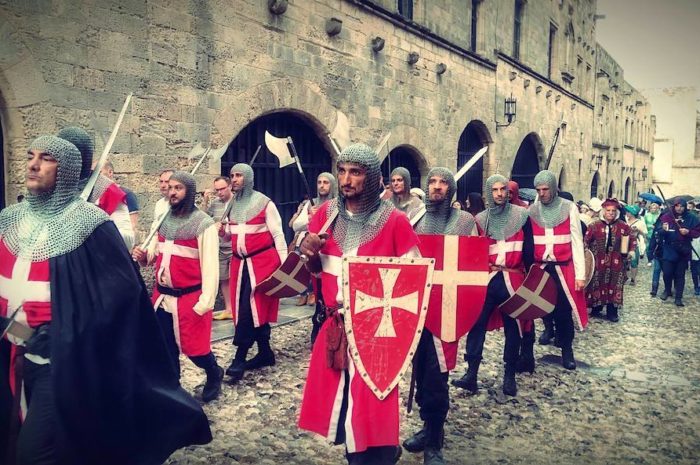
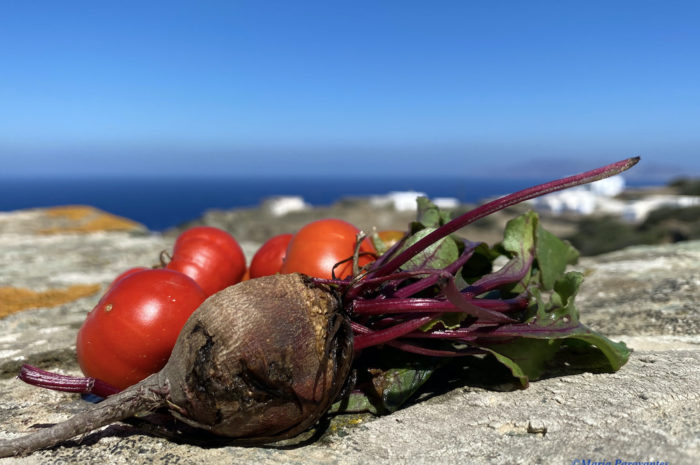
Love Greek culture so much. Reminds me of my family in Spain. Mediterranean culture > everything else
Glad you enjoyed the read, Manu. Countries in the Mediterranean may be very different but they share the sense of outwardness that is truly magical.
What a fantastic post! Thank you!
Glad you enjoyed it, Mariana. Stay tuned for more!
Great post! I would love to have all of these experiences – especially the last one with the food!
Glad you enjoyed it. When travel reopens make it a plan.
Would love to experience some of these Unesco listed Traditions in Greece! Great article. Greece has been on my bucket list for decades!
Beautiful traditions and experiences that are unique. Thanks.